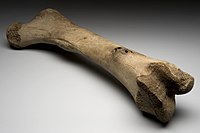
Photo from wikipedia
Literature on outcomes after SSRF, stratified for rib fracture pattern is scarce in patients with moderate to severe traumatic brain injury (TBI; Glasgow Coma Scale ≤ 12). We hypothesized that SSRF… Click to show full abstract
Literature on outcomes after SSRF, stratified for rib fracture pattern is scarce in patients with moderate to severe traumatic brain injury (TBI; Glasgow Coma Scale ≤ 12). We hypothesized that SSRF is associated with improved outcomes as compared to nonoperative management without hampering neurological recovery in these patients. A post hoc subgroup analysis of the multicenter, retrospective CWIS-TBI study was performed in patients with TBI and stratified by having sustained a non-flail fracture pattern or flail chest between January 1, 2012 and July 31, 2019. The primary outcome was mechanical ventilation-free days and secondary outcomes were in-hospital outcomes. In multivariable analysis, outcomes were assessed, stratified for rib fracture pattern. In total, 449 patients were analyzed. In patients with a non-flail fracture pattern, 25 of 228 (11.0%) underwent SSRF and in patients with a flail chest, 86 of 221 (38.9%). In multivariable analysis, ventilator-free days were similar in both treatment groups. For patients with a non-flail fracture pattern, the odds of pneumonia were significantly lower after SSRF (odds ratio 0.29; 95% CI 0.11–0.77; p = 0.013). In patients with a flail chest, the ICU LOS was significantly shorter in the SSRF group (beta, − 2.96 days; 95% CI − 5.70 to − 0.23; p = 0.034). In patients with TBI and a non-flail fracture pattern, SSRF was associated with a reduced pneumonia risk. In patients with TBI and a flail chest, a shorter ICU LOS was observed in the SSRF group. In both groups, SSRF was safe and did not hamper neurological recovery.
Journal Title: European Journal of Trauma and Emergency Surgery
Year Published: 2022
Link to full text (if available)
Share on Social Media: Sign Up to like & get
recommendations!